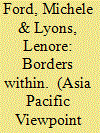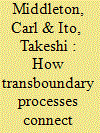|
|
|
Sort Order |
|
|
|
Items / Page
|
|
|
|
|
|
|
| Srl | Item |
| 1 |
ID:
072726


|
|
|
|
|
| Publication |
2006.
|
| Summary/Abstract |
The border studies literature makes a strong case against claims for unfettered transnationalism and 'borderlessness' in our 'globalising world'. However, its focus on movement across borders means that it fails to address bordering practices that occur within the nation-state as a result of transnational activity. In this paper, we extend Cunningham and Heyman's concepts 'enclosure' and 'mobility' to confront the different layers of bordering (both physical and non-physical) that have occurred in Indonesia's Riau Islands since they became part of the Indonesia-Malaysia-Singapore Growth Triangle.
|
|
|
|
|
|
|
|
|
|
|
|
|
|
|
|
| 2 |
ID:
174816


|
|
|
|
|
| Summary/Abstract |
In this paper, with a focus on Japan and Thailand, we outline a relational environmental and economic history of East Asian economic integration (EAEI) and its implication for the commons in both places. We draw attention in particular to global commodity chains as relational processes not only of trade and investment, but also geopolitics and aid, to argue that these transborder processes have connected together commons in distant localities resulting in their simultaneous enclosure, dispossession and (re‐)commoning with implications for community vulnerabilities in positive and negative ways. To demonstrate this argument we analyse three periods of EAEI: the late nineteenth century until World War II, when Japan and Thailand both began to modernise and new trade and geopolitical relations emerged in the context of colonialism; the post‐World War II recovery until the Plaza Accord in 1986, during which time Japan rapidly industrialised, as did Thailand to a lesser extent and regionalism was largely defined by US hegemony; and the post‐Plaza Accord period, when Japan deindustrialised its labour intensive manufacture and heavy industry and Thailand rapidly industrialised and EAEI became defined by new and intensified global commodity chains.
|
|
|
|
|
|
|
|
|
|
|
|
|
|
|
|
| 3 |
ID:
094821


|
|
|
|
|
| Publication |
2010.
|
| Summary/Abstract |
The last century of the Ottoman Empire saw an intense move to build clock towers in Anatolia. Among the reasons for this move were the central government's desire to advertise its sovereignty in the provinces, its desire to secularize the same periphery, and that clock towers were a means for Christians to erect church towers. Compounding this already complex layering of meanings, these towers were often erected under the pretext that they would help announce the daily times of prayer. After the proclamation of the Turkish Republic in 1923, this move continued in a new guise: clock towers were attached to modern-style buildings that advertised the republican project. Using documents from the Archives of the Prime Ministry and other primary sources, this paper attempts to trace the proliferation of clock towers in Anatolia and how the meanings attached to these edifices changed through time.
|
|
|
|
|
|
|
|
|
|
|
|
|
|
|
|
| 4 |
ID:
147455


|
|
|
|
|
| Summary/Abstract |
In colonial Southeast Asia, the process of enclosure aimed to integrate communities living in the borderlands, along with their lands and resources, into the state project. In 1891, the newly established French colonial administration in Tonkin (northern Vietnam) decided the upland region bordering China should be physically and administratively enclosed to achieve these aims. The governor general ordered the French military to administer these borderlands and to complete two surveys of local ‘tribes’ in 1897–1898 and 1903–1904 to make upland populations and their livelihoods more legible and, the administration hoped, more controllable. By examining details of these surveys, we not only obtain proof of this enclosure project but we also gain rare insight into and a snapshot of upland border livelihoods at the turn of the 20th century. The surveys reveal details regarding local cross-border trade strategies, marketplace manoeuvres, the means by which the colonial government enforced a common currency and, despite such attempts, the enduring nature of barter. We probe how local populations reacted to the state's processes of legibility, and in particular, how upland residents adapted their trade livelihoods to the new realities of being included within the colonial state and, progressively, within the national economy.
|
|
|
|
|
|
|
|
|
|
|
|
|
|
|
|
|
|
|
|
|